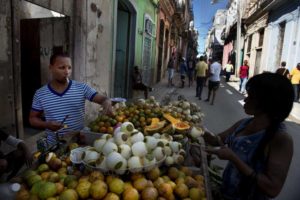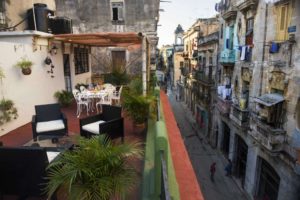Welcome to Cuba, my native land: a place where time seems out of joint and where all the old certainties are jumbled.
Surprises confront first-time visitors from the moment they leave Havana’s airport. Yes, there are images of Che Guevara and Camilo Cienfuegos, together with Fidel Castro: the triumvirate of the Cuban revolution. While corporate advertising is scarce, political propaganda still appears; similar visual displays have disappeared in other countries. Of course, Cuba’s communism was never the grim Soviet system. Ours was a tropical invention, spiked with salsa and humor, Cubans’ best survival tool.
On the island, amid the colonial architecture and 1950s cars, you enter another dimension. You’ve seen photos of scenes like these, perhaps in a book or movie, but are you really seeing them now?
Habana Vieja, or Old Havana, where the country’s capital was born, is one of seven UNESCO World Heritage sites in Cuba. Many buildings there have been restored to their full splendor, but others are vivid testaments to time, crumbling into ruins, untouched. For centuries the city was the main port of entrance to Spain’s New World colonies. Zigzagging through the narrow, stone-paved streets, you see the beauty and fortitude of colonial mansions and military fortresses built to defend Havana from pirate attacks and foreign invasions.
Castles border the Havana seawall, and state-of-the-art cruise ships pass nearby. Kids of all colors dive into the water from the reef where their elders are fly-fishing for dinner. Nearby, a trio of guitar players sings a serenade. A few feet from them, a man reclines on the breakwater meditating, his face fixed on the horizon, intent on whatever it is that his headphones are emitting. Music is our collective catharsis, our national therapy.
It’s no accident that Cuba is the birthplace of genres such as the Salsa, Son, Mambo, Chachachá, Rumba, Conga and Cuban Latin Jazz. Instead of despairing, we dance.
The “mejunje,” we call it: the mixture. In Cuba, diversity is an understatement. We are “un mejunje,” a multicolor human concoction that has produced a strong Latin American culture.
On the seawall, couples exchange sea-salty kisses. Women dressed all in white wet their feet; they are worshipping Yemayá, the Santería deity that rules over the sea. Then, at the nearby Catedral de La Habana, the same women kneel before altars to Jesús Cristo or La Virgen María.
In the ’40s and ’50s, Ernest Hemingway was the celebrity who drank mojitos five steps away, at La Bodeguita del Medio. Nowadays it’s Madonna, Beyoncé, Natalie Portman or Chanel’s Karl Lagerfeld. Katy Perry said that Cuba has “one of the coolest vibes alive.”
Celebrities also come to the island for cigars. At the historic Partagás Factory in Centro Habana, visitors watch the “torcedores” roll cured “colorado’s,” dark-blonde, spicy, oily leaves; it’s practically an obligatory stop. But it’s hardly the only exceptional cigar place that feels stuck in the first half of the 20th century, when the island was the entertainment back yard of wealthy Americans.
Connoisseurs and those who enjoy the outdoors travel to the exuberantly beautiful Valle de Viñales, the valley about two and a half hours from Havana, where tobacco is grown and cured. In Spanish, a cigar is a “puro”: pure nature.
Even nature seems vintage, full of ecosystems barely touched by modernity. Cuba, the largest nation in the Caribbean Sea, includes 4,000 islands and cays. Scuba divers prize Jardines de la Reina Marine Park, nicknamed as “The Galapagos of the Caribbean,” on the southeast side of Cuba. It’s known for its diverse and abundant sharks. To protect it, a limited number of visitors are admitted each year.
Cuba is like a bottle of wine found at the bottom of the Caribbean Sea. The taste is familiar and strange, too complex to decipher quickly. Give it time. And enjoy.
(Opinión) La más Enigmática isla del Caribe, Cuba.
Bienvenidos a Cuba, mi tierra natal: un lugar donde el tiempo parece desordenado y donde todas las viejas certezas se confunden.
Las sorpresas enfrentan a los visitantes por primera vez desde el momento en que salen del aeropuerto de La Habana. Sí, hay imágenes del Che Guevara y Camilo Cienfuegos, junto con Fidel Castro: el triunvirato de la revolución cubana. Mientras que la publicidad corporativa es escasa, la propaganda política todavía aparece; Pantallas visuales similares han desaparecido en otros países. Por supuesto, el comunismo cubano nunca fue el sombrío sistema soviético. La nuestra era una invención tropical, llena de salsa y humor, la mejor herramienta de supervivencia de los cubanos.
En la isla, entre la arquitectura colonial y los coches de los años cincuenta, se entra en otra dimensión. Has visto fotos de escenas como éstas, tal vez en un libro o película, pero ¿realmente las estás viendo ahora?
Habana Vieja, o La Habana Vieja, donde nació la capital del país, es uno de los siete sitios de Patrimonio Mundial de la UNESCO en Cuba. Muchos edificios allí se han restaurado a su esplendor completo, pero otros son testamentos vivos al tiempo, desmenuzándose en ruinas, intacto. Durante siglos la ciudad fue el principal puerto de entrada a las colonias del Nuevo Mundo de España. Zigzagging a través de las estrechas calles pavimentadas de piedra, se ve la belleza y la fortaleza de las mansiones coloniales y fortalezas militares construidas para defender La Habana de los ataques de piratas y las invasiones extranjeras.
Los castillos bordean el malecón de La Habana, y los cruceros de última generación pasan cerca. Los niños de todos los colores se zambullen en el agua del arrecife donde sus mayores son la pesca con mosca para la cena. Cerca, un trío de guitarristas canta una serenata. A pocos metros de ellos, un hombre se reclina sobre el rompeolas meditando, su rostro fijo en el horizonte, atento a lo que sea que sus auriculares emiten. La música es nuestra catarsis colectiva, nuestra terapia nacional.
No es casualidad que Cuba sea el lugar de nacimiento de géneros como la salsa, el son, el mambo, el chachachá, la rumba, la conga y el jazz latino cubano. En lugar de desesperar, bailamos.
El mejunje, lo llamamos: la mezcla. En Cuba, la diversidad es un eufemismo. Somos “un mejunje”, una mezcla humana multicolor que ha producido una fuerte cultura latinoamericana.
En el malecón, las parejas intercambian besos salados del mar. Las mujeres vestidas de blanco mojaron sus pies; Están adorando a Yemayá, la deidad Santería que rige sobre el mar. Luego, en la cercana Catedral de La Habana, las mismas mujeres se arrodillan ante altares a Jesús Cristo o La Virgen María.
En los años 40 y 50, Ernest Hemingway fue la celebridad que bebió mojitos a cinco pasos de distancia, en La Bodeguita del Medio. Hoy en día es Madonna, Beyoncé, Natalie Portman o Chanel Karl Lagerfeld. Katy Perry dijo que Cuba tiene “una de las vibraciones más cool con vida”.
Celebridades también vienen a la isla para los puros. En la histórica fábrica de Partagás, en Centro Habana, los visitantes observan los “torcedores” curados “colorados”, hojas oscuras, picante, aceitosas; Es prácticamente una parada obligatoria. Pero no es el único lugar de cigarros excepcional que se siente atrapado en la primera mitad del siglo 20, cuando la isla era el patio trasero de entretenimiento de los estadounidenses ricos.
Los conocedores y los que disfrutan del aire libre viajan al exuberantemente hermoso Valle de Viñales, el valle a unas dos horas y media de La Habana, donde se cultiva y cura el tabaco. En español, un puro es puro: naturaleza pura.
Incluso la naturaleza parece antigua, llena de ecosistemas apenas tocados por la modernidad. Cuba, la nación más grande del Mar Caribe, incluye 4.000 islas y cayos. Los buceadores premian el Parque Marino Jardines de la Reina, apodado “Las Galápagos del Caribe”, en el lado sureste de Cuba. Es conocido por sus diversos y abundantes tiburones. Para protegerlo, se admite un número limitado de visitantes cada año.
Cuba is like a bottle of wine found at the bottom of the Caribbean Sea. The taste is familiar and strange, too complex to decipher quickly. Give it time. And enjoy.
Agencies/Houston Chronicle/Olivia P. Tallet/Michael Ciaglo Photos/Arnoldo Varona/TheCubanHistory.com
THE CUBAN HISTORY, HOLLYWOOD.



 > (OPINION) The Most Enigmatic island of the Caribbean, Cuba. + (OPINIÓN) La más Enigmática isla del Caribe, Cuba.
> (OPINION) The Most Enigmatic island of the Caribbean, Cuba. + (OPINIÓN) La más Enigmática isla del Caribe, Cuba.






